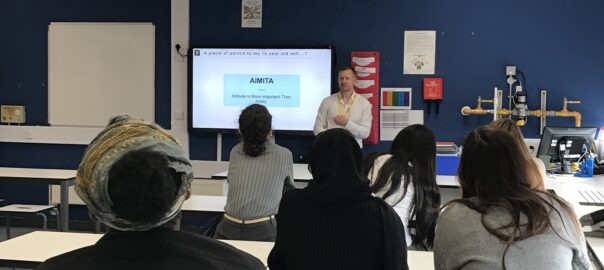The Count on Us Challenge Across Key Stage Three

Chris Olley, The Maths Zone
The activities and materials of the Count on us Challenge have been designed to support a wide range of mathematical topics across all areas of the Key Stage Three curriculum. So, by now you will have been able to get all your Key Stage Three students involved! You, as the coordinator in your school for the Challenge, will be able to use the activities for your own classes, so the next step is to get the whole department involved.
The first thing is to have a look through the department scheme of work to see where and when particular topics are being taught. The easiest and most obvious will be any points where geometry topics crop up, notably angle relationships, area and volume, similarity and Pythagoras’ Theorem, then GridLines Geometry cards can be used. Secondly, where students normally practice their mental numeracy, the single and double digit 24® Game cards will come in. Then the three specialist packs can be used in lessons on arithmetic of fractions and decimals, negative numbers (the integers cards), squares/square roots, cubes/cube roots (the indices cards within the algebra set) and substituting into formulae (the other algebra cards). The Hedgehog game is ideal to be used in any lesson on probability, but certainly when the topic is first introduced. Equally when you introduce any statistical charts they will be a given a sense of purpose and reality using the data-chart-analysis materials. So, make a table to show where these things will be taught across key stage three so you can share with the rest of the department.
I’ve always found that the point at which everyone gets hooked is when you actually play the game. So, book in some time at a department meeting and get them playing. Hedgehog is quickest and very immediately just fun to play, so start with that. Then the 24® Game, because the rules are easy to explain, but you have to get your colleagues past the point where they think it is too hard! This doesn’t take long, but don’t put them under too much pressure and don’t reveal the answers, instead let them take a card away and bring it back later to tell you. Next, GridLines Geometry is complicated mainly because of the rules for the number cards. The puzzle cards on their own are easy to get started, so just show some level zero cards and ask people to find any possible solution, then another, then another. With Data-Chart-Analysis I would suggest making up a set for each of your colleagues and handing them out. Just explain that they must match the cards in sets of three and fill in the table on the answer sheet. That should be enough. Then they can show you later, any time.
If you can’t get enough time in a meeting, just carry a few cards and some dice around, so you can engage people in informal times or over lunch. The games are good fun so this is not a burden for them. So, now the whole department is ready to go. They know when the topics are being taught and now at the start of the lesson, show a GridLines Geometry or 24® Game card to the class (or stick it under a visualiser, or scan it and put it on screen – whatever works) and let students find a solution for themselves. Maybe the first time, the teacher can take solutions and share them, but thereafter keep the pressure off by not revealing solutions, so even the least competitive students have the chance to think it through. Then get out the dice when probability is being taught and have packs of D-C-A cards ready for statistical charts lessons where it is a perfect group thinking then class discussion activity.
Notice, I haven’t mentioned the Algebra round. That works a little differently and will be the subject of a future blog. For now, make your focus to get everyone involved, starting with your own students, then your colleagues and thus their students. Please, keep count of numbers involved, take photos if you can and share with us, and write and tell us of your experiences so we can share them. Thank you – good luck!



